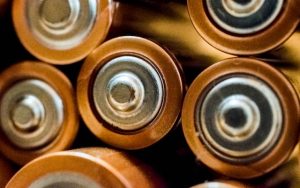Lithium Ion Batteries

Among the many types of rechargeable batteries, lithium Ion is one of the most commonly used. In addition to being a power source for electric vehicles, this type of battery is also used in consumer electronics and portable devices. It is a type of battery that uses a reversible reduction of lithium ions.
Cathode
During the charge-discharge process, Li+ ions flow in and out of electrode structures. To enhance the intercalation of lithium ions, particle agglomeration has been proposed. However, the most effective means of promoting Li+ insertion/extraction is to increase the affinity of the ionic species to the surface. This increased affinity, in turn, leads to a higher propensity for the ionic specie to reach the outermost surfaces.
In order to achieve the best cathode properties, conductive carbonaceous material coating on the cathode material is a viable option. Such a coating provides high conductivity, superior electrochemical stability, and a protective barrier against the electrolyte. It also mitigates detrimental effects of the interfacial reactions.
A thin, disordered layer on the cathode shell may be sufficient to suppress chemical delithiation, while maintaining a small number of Li+ ions. Moreover, a low doping level is sufficient for the necessary electrochemical performance. The morphology of the resulting products is important for monitoring nucleation and growth kinetics.
One of the most promising carbonaceous materials is graphene. It has a unique single atomic layered morphology, and is tunable to a degree. It is also an effective electron conductor. This is because its polarity is compatible with the electrolyte.
A key metric in understanding the process is the critical thickness of the passivation layer. This is determined by the morphology of the reaction layer. In a well-ordered and stable SEI, side reactions will slow down drastically. A broken LiOH layer will remain inert, but further exposure to water vapor will not result in continued growth.
Another useful electrochemical observation is the presence of the magnetic exchange interaction. This is a relatively short-range interaction in semiconductors, and is often used in combination with conventional tools. It is able to detect local defects and impurity phases.
Anode
During electrochemical cycling, the anode of lithium ion undergoes various volumetric changes. Excessive volumetric changes induce pulverization and cracking. This decreases the Coulombic efficiency, and consequently, the reversible capacity of the anode. To improve the performance of anodes, novel stable structures have been developed.
Silicon-carbon composite anodes have been studied extensively to achieve higher electronic conductivity and cycle stability. However, they have been hampered by the poor Coulombic efficiency and low cycle life. To improve their performance, polymer coating on the particles was suggested. A binder polymer composite was prepared by combining a carboxylate-containing polymer (PAA) with an n-doped conducting polymer (P-BIAN). The binder polymer stabilized the anode. During the first hundred cycles, the carbon-coated Si nanopowder anodes showed good stability.
Amorphous silicon is an advantageous anode material for lithium-ion batteries. It has better fracture resistance compared to crystalline Si. It is also abundant and therefore, a low-cost material. In addition, the internal porosity of silicon accommodates large volume changes. The formation of hydrogen bonds between the particles helps the structure to self-repair.
Several characterization platforms have been developed to combine multiple advanced techniques to monitor the morphological and mechanical evolution lithium Ion of anode materials. These advanced techniques provide in-depth information on the chemical evolution, crystallographic evolution, and morphological transformation of the anode. A combined XRD and optical microscopy station has been utilized to probe the macroscale morphological evolution of the anode.
Moreover, in situ TEM was employed to study the fracture of the silicon anode. Using this technique, the researchers were able to identify dendrites formed by the anode. In addition, they performed auger spectroscopy to quantify lithium in the entire shell. These results were published in ACS Applied Energy Materials.
Nominal output voltage
Unlike other battery types, lithium ion batteries can actually have different nominal output voltages. The average voltage is 3.7V, while the highest voltage can be as high as 4.2V.
The nominal voltage of a single lithium ion cell is determined by the chemistry of the anode and cathode materials. For instance, a nickel metal hydride (NiMH) has a nominal voltage of 1.2V, while lithium titanate has a nominal voltage of 2.40V.
A battery’s nominal output voltage is the midpoint between the full charge and the full discharge. Using the right charging algorithm can maximize the battery’s life.
The most important thing to know about the lithium ion’s nominal output voltage is that the maximum charge and discharge are not the same. This is because the battery’s maximum capacity is reduced as the battery is discharged. The best way to maximize the life of your Lithium-Ion battery is to combine several cells in series.
The best charging method for a single Lithium-Ion battery is the constant current mode (CC-CV). The CC-CV allows the battery to be charged up to the maximum rate. The CC-CV is more efficient and can save you a lot of money on batteries.
The other obvious lithium ion battery function is the ability to discharge a large amount of energy in a short period of time. The lithium ion’s ability to handle higher voltages is due to the addition of additives in the electrolyte. The higher the voltage, the more energy can be stored.
Besides the lithium ion’s nominal outputvoltage, there are several other lithium ion battery functions that are worth considering. The best way to determine the actual output voltage of a single Lithium-Ion cell is to check the label.
Discharge rate
Compared to other types of batteries, the lithium ion discharge rate is pretty impressive. The battery itself is quite expensive, but it has a lot of power. There are different battery designs, but most of them have a standard discharge rate of about 0.25C.
The higher the rate, the more power you get from the battery. This is because the cell stores the energy as chemical energy in the cell. The electrons flow from the negative electrode to the positive electrode through an external circuit. This energy is transferred to the dissipating electric current.
A typical 5,000mAh (5Ah) battery can discharge at a rate of 1,000mAh per hour. This is more than you might think. In real world usage, this will not be a problem.
However, it is important to know that the rate of self-discharge is not linear. This will depend on the temperature of the battery. For example, if the battery is very hot, the self-discharge rate will increase.
There are a few ways to slow the self-discharge process. For one, you should always charge the lithium ion battery early. You should also keep it in a cool place. When not in use, the lithium ion battery should be charged to 80% or less. This will help preserve the battery’s life.
Using the right cell in a lithium lithium Ion ion battery pack can make all the difference. For instance, selecting a cell with a higher C rating will extend the life of the battery and leave room for safety.
It is also important to understand the different application requirements for a particular battery. Understanding the demands will help you avoid wasting power and will even prevent damage to the battery.
Safety hazard
Several lithium ion battery fires have recently occurred. These incidents are expected to rise with the increased use of electric vehicles. They also pose a serious safety hazard to firefighters. The fires tend to spread rapidly, making it difficult to extinguish.
One of the most important safety hazards of lithium ion batteries is thermal runaway. This can cause internal or external short circuits. It can also lead to a loss of capacity in the cell. The main reason for this safety hazard is the formation of a combustible gas by the electrolyte interface.
This safety hazard is the result of chemical reactions that occur in the cell when charging or discharging. In addition, cyclic aging and overcharging are common in lithium ion batteries.
The first positive active material is a polymer material that contains between 10 and 60% of conductive material. It has been reported that the first positive active material content of a battery increases when the temperature of the battery is raised. The higher the temperature, the faster the response of the PTC effect. The safety performance of a battery can be greatly improved by choosing the first polymer material.
The negative active material is a carbonaceous material. This material can be a metal, a semimetal, or a conductive carbon black. The safety performance of a battery can also be improved by using the PTC safety coating. The coating can prevent nail penetration and improve the electrical properties of the battery.
A negative electrode plate in a lithium ion battery is designed to meet the requirements of a secondary battery. It is prepared by applying an active material graphite on a copper foil and drying it under vacuum at 110deg C for 4 hours.


